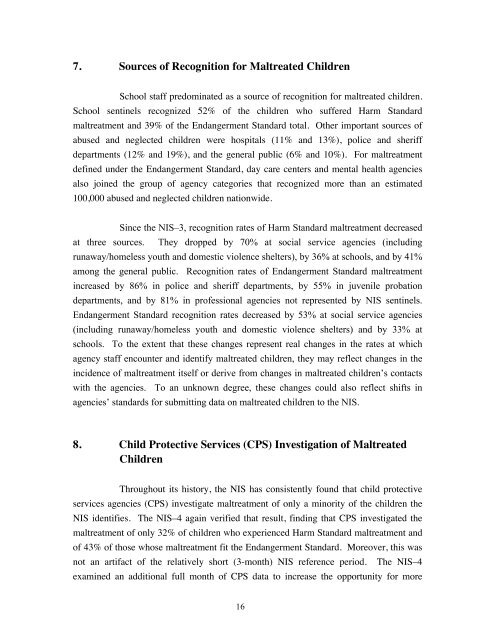National Incidence Study of Child Abuse and ... - Children's Central
National Incidence Study of Child Abuse and ... - Children's Central
National Incidence Study of Child Abuse and ... - Children's Central
- No tags were found...
You also want an ePaper? Increase the reach of your titles
YUMPU automatically turns print PDFs into web optimized ePapers that Google loves.
7. Sources <strong>of</strong> Recognition for Maltreated <strong>Child</strong>renSchool staff predominated as a source <strong>of</strong> recognition for maltreated children.School sentinels recognized 52% <strong>of</strong> the children who suffered Harm St<strong>and</strong>ardmaltreatment <strong>and</strong> 39% <strong>of</strong> the Endangerment St<strong>and</strong>ard total. Other important sources <strong>of</strong>abused <strong>and</strong> neglected children were hospitals (11% <strong>and</strong> 13%), police <strong>and</strong> sheriffdepartments (12% <strong>and</strong> 19%), <strong>and</strong> the general public (6% <strong>and</strong> 10%). For maltreatmentdefined under the Endangerment St<strong>and</strong>ard, day care centers <strong>and</strong> mental health agenciesalso joined the group <strong>of</strong> agency categories that recognized more than an estimated100,000 abused <strong>and</strong> neglected children nationwide.Since the NIS–3, recognition rates <strong>of</strong> Harm St<strong>and</strong>ard maltreatment decreasedat three sources. They dropped by 70% at social service agencies (includingrunaway/homeless youth <strong>and</strong> domestic violence shelters), by 36% at schools, <strong>and</strong> by 41%among the general public. Recognition rates <strong>of</strong> Endangerment St<strong>and</strong>ard maltreatmentincreased by 86% in police <strong>and</strong> sheriff departments, by 55% in juvenile probationdepartments, <strong>and</strong> by 81% in pr<strong>of</strong>essional agencies not represented by NIS sentinels.Endangerment St<strong>and</strong>ard recognition rates decreased by 53% at social service agencies(including runaway/homeless youth <strong>and</strong> domestic violence shelters) <strong>and</strong> by 33% atschools. To the extent that these changes represent real changes in the rates at whichagency staff encounter <strong>and</strong> identify maltreated children, they may reflect changes in theincidence <strong>of</strong> maltreatment itself or derive from changes in maltreated children’s contactswith the agencies. To an unknown degree, these changes could also reflect shifts inagencies’ st<strong>and</strong>ards for submitting data on maltreated children to the NIS.8. <strong>Child</strong> Protective Services (CPS) Investigation <strong>of</strong> Maltreated<strong>Child</strong>renThroughout its history, the NIS has consistently found that child protectiveservices agencies (CPS) investigate maltreatment <strong>of</strong> only a minority <strong>of</strong> the children theNIS identifies. The NIS–4 again verified that result, finding that CPS investigated themaltreatment <strong>of</strong> only 32% <strong>of</strong> children who experienced Harm St<strong>and</strong>ard maltreatment <strong>and</strong><strong>of</strong> 43% <strong>of</strong> those whose maltreatment fit the Endangerment St<strong>and</strong>ard. Moreover, this wasnot an artifact <strong>of</strong> the relatively short (3-month) NIS reference period. The NIS–4examined an additional full month <strong>of</strong> CPS data to increase the opportunity for more16
















